2018
Average Yield and Protein of Spring Wheat in Response to S and N Treatment (NW Minnesota, 2015-2017)
Several trials were conducted in the Red River Valley area of Minnesota from 2015 to 2017 to assess the impact of sulfur (as ammonium sulfate) fertilization and nitrogen (urea) on yields and protein of spring wheat.
- The sites included Ada (2015 to 2017), East Grand Forks (EGF – 2015), Thief River Falls (TRF – 2015, 2016), Red Lake Falls (RLF – 2016), and Gentilly (2017).
- The soil texture at each site, from lightest to heaviest, was sandy loam (Ada, TRF), Loam (RLF, Gentilly), silty clay loam (EGF)
- Soybean was previous crop. N rates were applied on top of soil test N, which ranged from 22 to 62 lbs/ac. Treatments were surface applied and incorporated before seeding.
Results
- Means of yields and protein are presented in the table below.
- From the results observed, yields were increased by N rates at statistically significant levels at all sites except one (EGF, 2015). Grain protein was enhanced by N.
- Sulfur application resulted in statistically significant effects on yields in two (Ada – 2015, and TRF – 2016) out of the 8 trials.
- The soil organic matter (SOM) content at the two responsive sites was always < 3%. Three of the trials with SOM < 3% and the other three trials with SOM > 3% did not show significant yield response to S.
- Across all trials, S application resulted in two-bushel increase from 10 or 20 lbs. S versus 0 lbs S. Grain protein increased by 0.17% at 10 lbs. S, and by 0.23% at 20 lbs. S.
- Ten pounds of S was enough to satisfy the S demands of the crop for these trials and was more economical than 20 lbs S.
- The amount of precipitation in the fall and spring was high enough to have explained the S response at Ada and TRF. Low inherent soil S content and low S mineralization were the main reasons for yield responses.
- Application of S above the 15 lbs. recommendation will likely not result in economic returns.
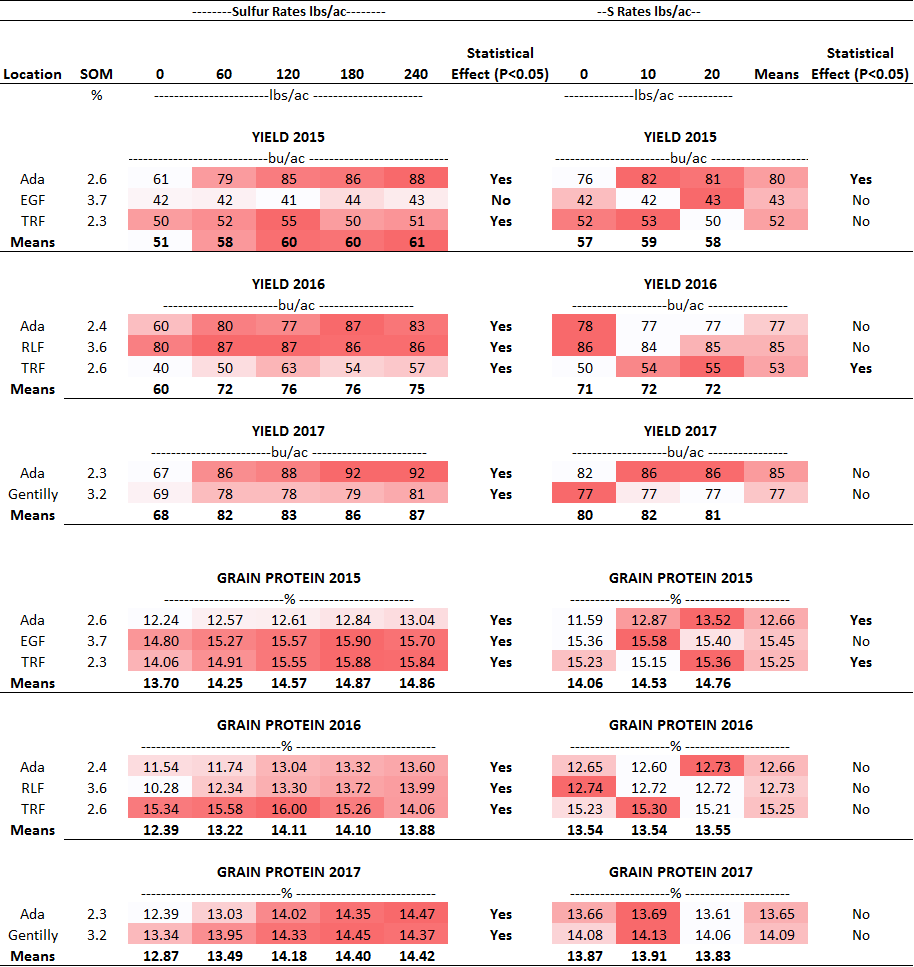
Acknowledgement: Funding for this project was provided by the Minnesota Wheat Research and Promotion Council.
Jasper M Teboh, Ph. D.
Jasper.Teboh@ndsu.edu
Research Soil Scientist
Pinto Bean Production with Winter Rye – First year results
A field study was initiated at the CREC with support from Northarvest Dry Bean Growers Association to examine the performance of pinto bean with winter rye grown as a cover or companion crop. ‘ND Dylan’ rye was seeded in 7-inch rows at about 90 lb/A on September 20, 2016. ‘Lariat’ was direct planted into rye or rye residue (except tilled plots) in 21-inch rows on May 31, 2017. Rye (tillering stage) was preplant (PP) terminated by tillage on April 28 to establish a ‘check’ (treatment 1). Also, rye was PP terminated by glyphosate on April 28 (treatment 2). Rye (boot stage) was late PP terminated by glyphosate on May 27 (treatment 3). Treatment 4 plots were land rolled on June 6 with rye in the flowering stage. Raptor herbicide was applied on June 26 for terminating rye (dough stage) in treatments 4-5, and general weed control for treatments 1-3. Pinto bean seed was harvested with a plot combine in mid-October.
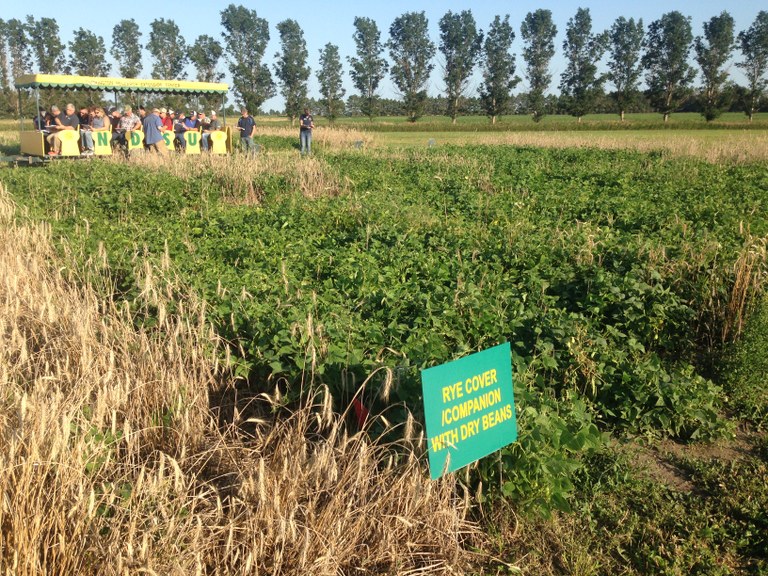
Early PP rye termination resulted in quicker pinto bean plant emergence (5-8 days), flowering (7-21 days), and maturity (5-26 days) compared to late PP and post-emergence (POST) rye termination (Table). Also, bean plants generally were taller, had a darker green color, and greater canopy closure with early PP rye termination versus later rye termination. With the exception of the early PP rye termination with herbicide, plant stand was similar among treatments. Seed yield was highest with early PP rye termination and lowest with POST rye termination. Test weight and seed size were similar among treatments with PP rye termination and greater than POST rye termination. The advantages with plant development, and seed yield with the early PP rye termination were likely due to greater soil moisture availability from reduced rye growth compared to the results with delaying rye termination, especially POST.
The study will continue in 2018.
Greg Endres
Gregory.Endres@ndsu.edu
Extension Agronomist
Greetings from the Fruit Project
Happy New Year! 2018 begins the 13th year of the Northern Hardy Fruit Evaluation Project and my 13th year as fruit project manager at the Carrington Research Extension Center. My knees are a little older, but my enthusiasm for working with hardy plants and meeting people who love fruits continues.
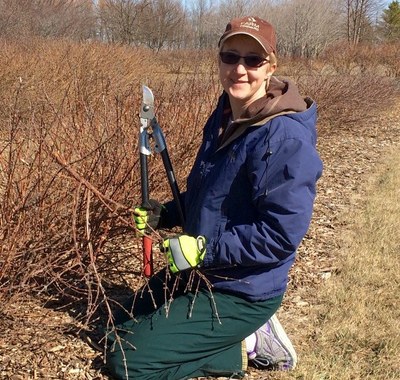
Pruning haskaps.
We opened the project to tours in 2007 (25 people!), and since then we have had over 10,000 contacts with fellow fruit-lovers in North Dakota and nearly a dozen other states. I’ve also had email conversations with people in Canada, Poland, Peru and Kazakhstan!
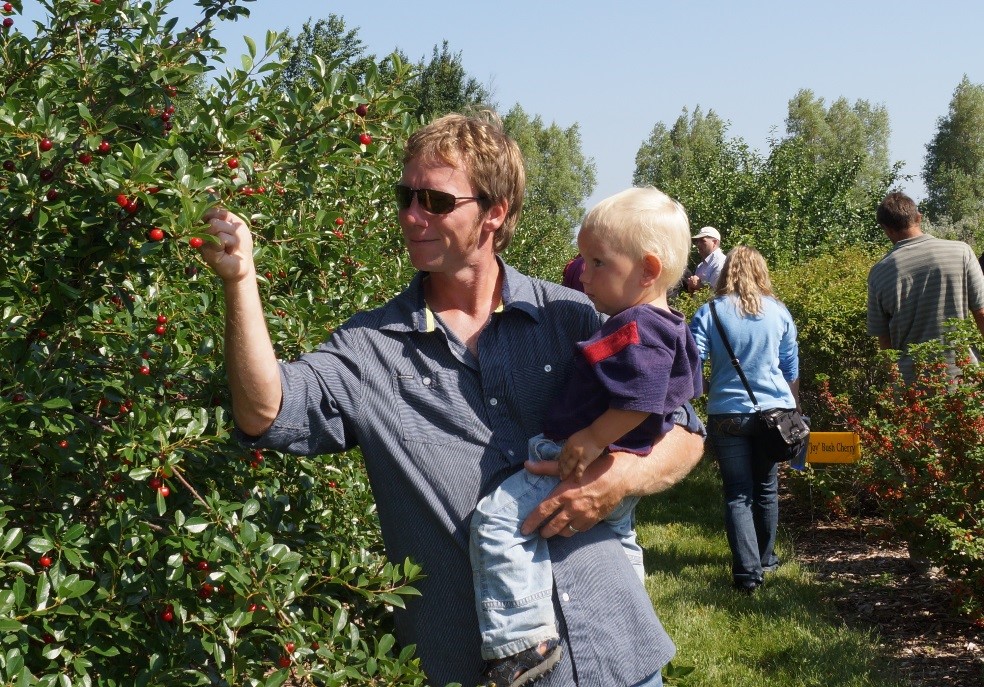
Tasting cherries. Field Day 2014.
Our summer students are an invaluable part of the CREC’s summer research program. I’ve had a super fruit-picking crew in recent summers and I miss the gals that have left for college. We’ve hand-picked over 9,500 pounds of fruit since 2009, not including apples, plums and grapes.
The CREC fruit goes out to Pride of Dakota companies that use fruit in their products, like kuchens, BBQ sauce, jellies/jams/syrups, and our biggest users: winemakers. Companies that want to try new products can request fruit for test batches. Companies that need fruit for established products can purchase it from the fruit project. In 2016 and 2017, we had leftover aronia, juneberry and black currants. We have become a victim of our own success for two reasons: new fruit orchards have started supplying fruit (Excellent!) and businesses that may have bought fruit from us in the past now use too much fruit to buy our relatively small amounts (Excellent, again)!
I keep busy in the off seasons, too, with pH, acidity and Brix readings on frozen fruit samples and writing up reports for the project and collaborators. In early, cold, 2017, the fruit project was featured on Minnesota Public TV’s Prairie Yard and Garden: http://www.pioneer.org/season-30.html It was so hot the day of taping that we all almost melted! Last winter I co-authored the “Starting a Community Orchard” publication with Extension horticulture specialist, Tom Kalb. I was also one of four coauthors for “The Windbreak Cookbook” publication. It is the 2017 second-place winner of the Notable State Government Document Award which means that it is now entered into the national competition at the annual American Library Association meeting. If you’d like a copy, ask for one when you stop by the CREC.
Thanks for being a part of the CREC Fruit Project. Now get busy thinking about all those interesting fruits you want to plant! The Fedco catalog is wonderful winter reading.
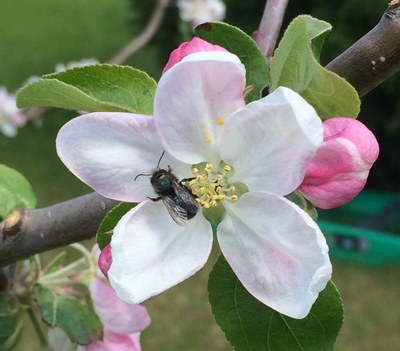
Apple Blossom and Blue Orchard Mason Bee
Kathy Wiederholt
Kathy.Wiederholt@ndsu.edu
Fruit Project Manager


